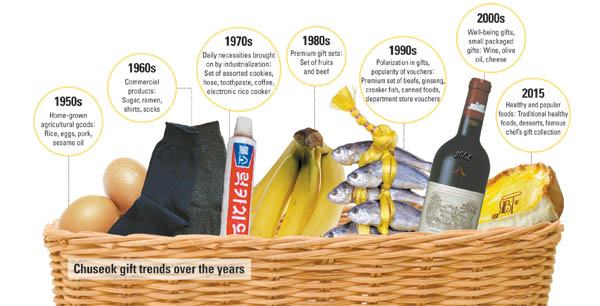Changing times reflected in gifts

Ads published 50 years ago in September, 1965, just days before the holidays, give a taste of the nation’s preferences.
“Do not hesitate, go for home brand socks for this year’s Chuseok!”
“Beksul sugar for gifts. 99.9 percent sweetness guaranteed”.
In the newspaper, there were stories about how items priced 1,000 to 2,000 won were popular at children’s clothing stores at Namdaemun and Dongdaemun. Stores were also selling a lot of rubber shoes for 60 to 100 won.
Holiday gifts also reflected lifestyles, habits and consumer interests at the time, and changes, and the country’s economic fortunes.
A look at gifting trends over the past 50 years ranges from a basket of eggs to imported products.
1950s to 60s
Right after the Korean War in the 1950s, there were no commercial gifts.
Instead, gifts comprised of flour, rice, eggs, pork, pepper and sesame, things that are home grown and chiefly aimed at satisfying hunger. In the 1960s, when the country is still recovering from the aftermath of the war, most popular gifts were daily necessities such as sugar, soap and spices. There still wasn’t enough food or daily amenities available.
Back in those times, sugar was often used as household medicine. When a person was infected with Shigellosis, they would drink a cup of sugar water mixed with buckwheat powder. Sugar water was also prescribed for stomach aches and was also served to house guests.
1970s
Koreans were feeling more prosperous during the 1970s with the country’s industrialization. There were plenty of jobs and companies were seeing their revenues spike.
Workers also enjoyed a big rise in their salaries year after year. During holidays, Koreans were happy to shop for gifts, and the options also increased to around 1,000 different items.
Cooking oil, toothpaste, shirts and leather goods were typical gifts. Prices ranged from 3,000 to 5,000 won. Sets of coffee products and assorted cookies were the best gifts for both soldiers and children.
Dongsuh Food’s Maxwell coffee set was popular along with the rise in the number of coffee houses. At the time, the Maxwell coffee set was the third most sold gift item among department store gift sets after sugar (Jeiljedang) and spice sets (Miwon).
1980s
As the country’s economic growth peaked, consumption culture developed and there were so many high-end holiday gifts available that there was a public campaign against costly holiday gifting.
As more Koreans sought personalized gifts, types of gifts increased to around 3,000.
In newspapers in 1982 ahead of Chuseok holidays, there are articles about gifts below 5,000 won including sake (4,200 won), powdered perilla seed (3,400 won) and six pairs of hose (2,880 won).
For more expensive gifts above 20,000 won, there were 3 kilograms of braised short ribs (26,000 won), royal jelly (29,000 won per 1 kilogram), Blackstone brand hard liquor (22,000 won for 2 bottles) and leather handbags (26,000 won to 43,000). Premium fruits and canned tuna gifts also emerged around this time.
1990s
Polarization between expensive gifts and less pricey ones became clearer around this time. As a growing number of consumers sought to save, low and mid-priced gift sets became popular. Among food items, regional foods were preferred over packaged ham or tuna. At the same time, super-expensive gifts like 1 million won imported foreign brand liquor or yellow croaker fish emerged and were sold robustly. Around this time, it became clearer that department store gift sets were for personal gifts, and discount retailer sets were for groups.
2000s
Polarization of gifts continued during this era. As the concept of “well-being” emerged, gifts such as health foods and supplements like ginseng and mushrooms became popular as well. Wine, olive oil, cheese and exotic foods like truffles, mango, melon, lobster and king crabs also sold well.
2015
Beef, fruits and croaker fish are still popular. But this year, traditional dishes and premium imported desserts are top gifts. Sesame oil, red pepper paste and salted sea foods made by artisans are popular. Brands like Mongchouchou (Japanese dessert maker), Godiva (Belgium chocolatier) and PNBPoongnyeon Bakery are well received. Chef-made foods and desserts, and imported items like New York’s Sarabeth fruit preserves and French Pierre Herme macarons are highly rated.
BY LEE SO-AH [park.jungyoun@joongang.co.kr]










with the Korea JoongAng Daily
To write comments, please log in to one of the accounts.
Standards Board Policy (0/250자)